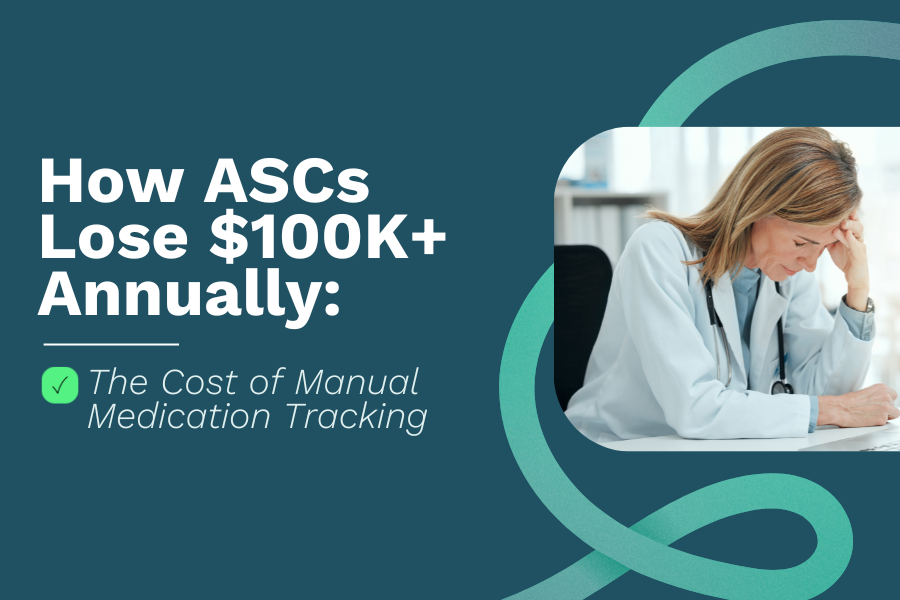How ASCs Lose $100K+ Annually: The Cost of Manual Medication Tracking
In ambulatory surgery centers (ASCs), accurate medication tracking is more than a routine task—it’s a critical part of patient safety, compliance, and operational efficiency. For many facilities, manual tracking methods like paper logs and spreadsheets are still the norm.
These outdated systems may seem simple, but they come with hidden costs. From lost staff time to inventory discrepancies and regulatory risk, manual medication tracking can quietly drain resources—and in many cases, cost ASCs well over $100,000 each year.
And that’s just the beginning—according to retired DEA Agent William "Bill" Matthews at the IAHSS North Texas Chapter Meeting (March 28, 2025), there have been 175+ DEA investigations across the country in the past 3 years. While the data comes from major hospital systems, the implications are even more serious for ASCs that often have fewer resources and leaner staff.
Let’s take a closer look at how manual tracking impacts your ASC’s bottom line—and how a modern solution can help reduce risk, improve accuracy, and protect your team.
Where the Losses Add Up
Time-Consuming Workflows
Manual medication tracking requires clinical staff to spend valuable time logging doses, verifying inventory, and resolving discrepancies. These small, repetitive tasks add up—pulling nurses, CRNAs, and techs away from direct patient care.
Over the course of a year, hundreds of hours can be lost to processes that could easily be streamlined with automation. It’s a hidden cost that many ASCs absorb without realizing the long-term impact on productivity and patient safety.
Untracked Medications and Inventory Gaps
Without real-time tracking, it’s easy for medication counts to fall out of sync. Missed doses, expired inventory, or unaccounted waste can go unnoticed until it’s too late.
This lack of visibility not only affects inventory accuracy—it also increases the risk of diversion. According to Matthews, drug diversion is linked to an estimated 110,000 deaths per year. When no one sees the gap, it becomes harder to fix and can cost you thousands.
Compliance Risks and Audit Stress
Manual logs leave more room for human error. A single missing signature or mismatch in inventory can raise red flags during DEA inspections or accreditation surveys.
And those red flags come at a steep price. Each "ding" from missing reports, order forms, or invoices can carry a maximum fine of $18,759. If the issue involves improper dispensation, administration, or prescription, that fine can jump to a staggering $80,850 per violation (Matthews, 2025).
Even when issues are resolved, the process can be resource-intensive. Facilities may face costly corrective actions and unnecessary scrutiny that affect their operations and reputation.
Matthews also emphasized that the DEA expects proactive, not reactive, compliance measures—and waiting until there’s a problem can result in penalties.
The Impact Goes Beyond Dollars
The cost of manual medication tracking isn’t only financial. It places added pressure on staff, increases the risk of medication errors, and creates uncertainty around compliance in an already demanding environment.
When tracking depends on someone remembering to log everything manually, the margin for error grows—and so does the stress on your clinical team. Over time, these small inefficiencies contribute to workflow disruptions, reduced morale, and even burnout.
Manual systems also make it harder to respond confidently during audits or quickly address discrepancies. Instead of focusing on patient care, your staff is left sorting through logs and retracing steps under pressure.
A Better Way to Manage Medications
MedServe’s secure narcotic cabinets are designed specifically for the needs of ASCs. Our goal is to simplify medication tracking, reduce risk, and ease the burden on clinical staff—without disrupting your existing workflow.
With MedServe, your ASC benefits from:
Automated tracking of every medication transaction, with time-stamped digital logs
Real-time inventory visibility, including alerts for discrepancies, expiration dates, or low stock
Secure access control using PINs, badges, or biometric ID
Digital audit trails to simplify reporting and inspection/survey readiness
Seamless integration with leading EHRs like HST Pathways, SIS, and Epic
By replacing manual tracking with a secure, automated system, ASCs reduce risk, save time, and gain peace of mind—every single day.
It’s Time to Move Forward
Manual tracking might feel manageable, but the risks and hidden costs make it an outdated solution for today’s ASC environment. From lost productivity to audit stress and medication errors, the impact adds up quickly.
And as DEA enforcement becomes more stringent, ASCs must act with urgency. Being reactive is no longer enough—compliance starts with prevention.
The good news? There’s a better way. Automating your medication tracking is a smart, scalable upgrade that helps your team stay compliant, efficient, and focused on patient care.
Ready to take control of your medication tracking?
MedServe helps your ASC reduce risk, save time, and gain lasting peace of mind with secure, automated medication management. Whether you're ready to explore a demo or just have questions, our team is here and ready to support you. Let’s take the first step toward smarter, safer medication tracking—together.
Schedule a call today and take the first step toward smarter, safer medication tracking.

